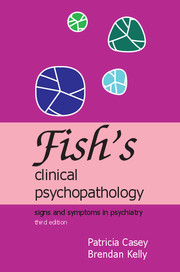Book contents
- Frontmatter
- Contents
- The authors
- Preface
- 1 Classification of psychiatric disorders
- 2 Disorders of perception
- 3 Disorders of thought and speech
- 4 Disorders of memory
- 5 Disorders of emotion
- 6 Disorders of the experience of self
- 7 Disorders of consciousness
- 8 Motor disorders
- 9 Personality disorders
- Appendix I Psychiatric syndromes
- Appendix II Defences and distortions
- Index
9 - Personality disorders
Published online by Cambridge University Press: 15 February 2018
- Frontmatter
- Contents
- The authors
- Preface
- 1 Classification of psychiatric disorders
- 2 Disorders of perception
- 3 Disorders of thought and speech
- 4 Disorders of memory
- 5 Disorders of emotion
- 6 Disorders of the experience of self
- 7 Disorders of consciousness
- 8 Motor disorders
- 9 Personality disorders
- Appendix I Psychiatric syndromes
- Appendix II Defences and distortions
- Index
Summary
Although personality disorder has no specific psychopathology, the problems associated with its distinction from Axis I disorders justifies its inclusion. True to the Germanic tradition of Schneider, who believed there was overlap between personality disorder and the neuroses, the ICD−10 Classification of Mental and Behavioural Disorders (ICD−10; World Health Organization, 1992) does not distinguish them either and classifies them on a single axis, whereas the Diagnostic and Statistical Manual of Mental Disorders (DSM−IV; American Psychiatric Association, 1994) classifies personality disorder on a separate axis from mental state disorders.
The history of personality disorder is one of the oldest in psychiatry dating back to Hippocrates, who believed that the balance between the four humours represented the different elements of personality, being identified as yellow bile from the liver, black bile from the spleen, blood and phlegm. These represented choleric (bad-tempered), melancholic (gloomy), sanguine (optimistic/confident) and phlegmatic (placid/apathetic) traits respectively.
The person who contributed most to our modern understanding of personality is undoubtedly Schneider, although his work Psychopathic Personalities for Modern Classificatory Schemes, first published in 1923, was not translated into English until 1950. He defined those with personality disorder as ‘those who suffer or make society suffer on account of their abnormality’, a view that is found in both of the contemporary classifications. He used the term ‘psychopathic’ in a broad sense to describe the totality of personality disorders, although this term has had a more restricted use in recent decades.
Definition
Personality can be defined as the totality of the person's emotional and behavioural traits that characterise their day-to-day living. Personality disorders are deeply ingrained, maladaptive patterns of behaviour, generally recognisable by adolescence and continuing throughout adult life.
Dimensions and categories
The modern understanding of personality is derived from trait psychology and it places traits on a continuum from absent to severe. Only those traits that reach a threshold for severity (impinging on self or others negatively) are regarded as pathological. In order to diagnose a specific personality disorder it is necessary to have a cluster of traits that are at or above this threshold. However, since most of the categories of personality disorder classified in ICD−10 and DSM−IV have not been validated and overlap with each other, there is debate about whether this categorical approach is the best way to conceptualise personality.
- Type
- Chapter
- Information
- Fish's Clinical PsychopathologySigns and Symptoms in Psychiatry, pp. 106 - 120Publisher: Royal College of PsychiatristsPrint publication year: 2007



